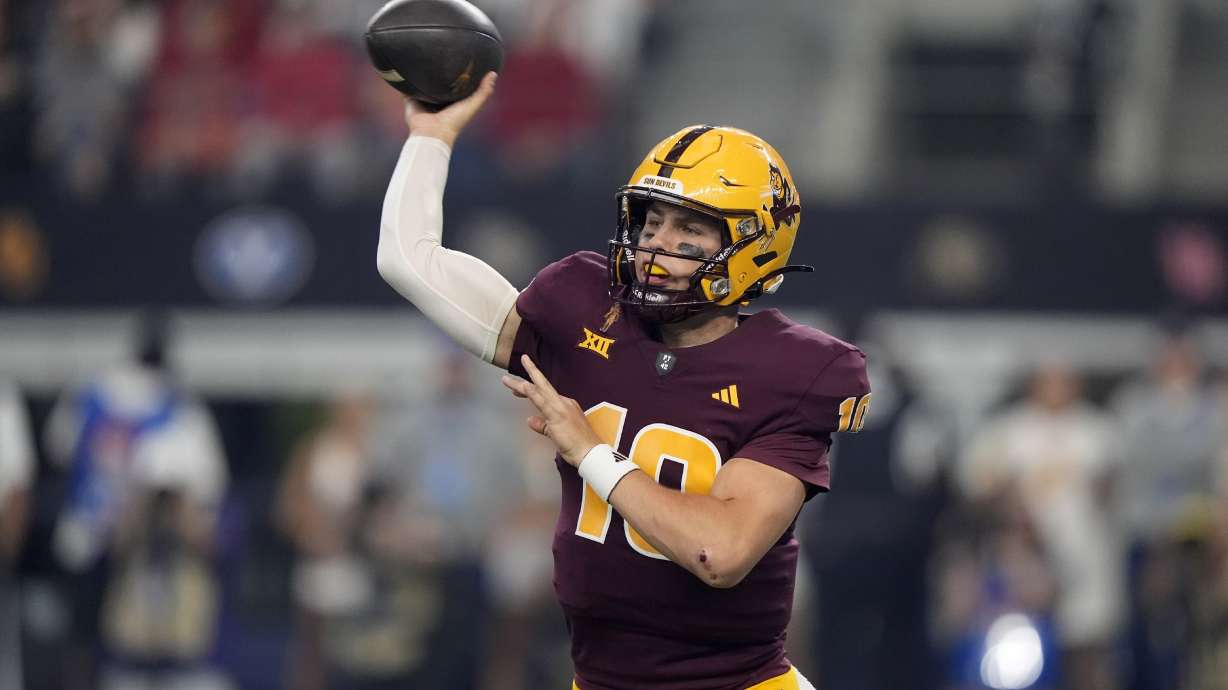SALT LAKE CITY — In an unexpected turn of events, a key Arizona State player may be unable to play against Utah on Saturday.
Dynamic dual-threat quarterback Sam Leavitt, who was listed as “probable” on the initial availability report Wednesday, was downgraded to “doubtful” late Thursday night.
It was a surprise move given that Leavitt has practiced all week and was the expected starter Saturday in a big-stakes Big 12 game at Rice-Eccles Stadium.
The extent of Leavitt’s injury remains unknown, though Arizona State head coach Kenny Dillingham told an Arizona radio station Friday morning that his star quarterback was injured against Baylor in Week 4 and has been playing dealing with it since then.
Though Leavitt had played against TCU two weeks ago and had made progress, the bye week and additional rest has not helped the situation to where he’s fully recovered, Dillingham said.
“He’s been fighting — fought through the TCU game,” Dillingham said. “Sam does everything he possibly can to try to come back and playing football games here. He’s the ultimate competitor. He’s gone to rehab, he’s gone to outside rehab. He’s done everything he could do to get back.
“Bye week was good for him to get kind of back, and then this week it just didn’t feel as good as we wanted to leaving Wednesday’s practice. So I think that’s an accurate deal.”
Dillingham doubled down on it being accurate and it not just being a gamesmanship tactic to trick Utah. The reporting, he said, is “an accurate reporting. Like, we’re going to be honest with that, so it’s accurate.”
“I’ll be shocked — I mean, if he plays in the game it’ll be a mini-miracle,” Dillingham added. “I’ll be absolutely shocked. I think this is the best thing for him and the future season. We’ll know this morning, this afternoon, final what it is when he comes in this morning and how he feels. But this is nothing new; it’s something that’s been going on and Sam is working his butt as hard as he can to get better and to be able to play in the game.”
Last season against Utah — in a game that was, at least on the Utah side, overshadowed by Cam Rising’s injury struggles in his last collegiate game — Leavitt was seriously injured in the first half, where he broke two ribs and punctured a lung.
With that as context, and the physical nature of play Utah’s defense is known to command, Dillingham is erring on the side of caution to help his starting quarterback heal up — or as he put it: “At the end of the day, we’ve got to protect people from people.”
Should Leavitt miss the game Saturday, Arizona State will turn to fifth-year senior and journeyman Jeff Sims, who started his collegiate career at Georgia Tech and then a season at Nebraska before ultimately landing with the Sun Devils.
Arizona State QB Sam Leavitt is listed as doubtful with an undisclosed injury against Utah. Kenny Dillingham said he’d be “shocked” if Leavitt could play.
“Sam’s been battling something going back to Baylor (on Sept. 20),” Dillingham told @Bickley_Marotta on Friday, adding that… pic.twitter.com/kI19mqQN6p
— Arizona Sports (@AZSports) October 10, 2025
The 6-foot-4 quarterback has yet to record any passing stats this season, but has three rushing attempts for a total of 22 yards in two games. Last season, Sims played in four games and finished throwing for just 168 yards on a 52% completion percentage, while adding 101 rushing yards and a score on 24 attempts.
As a freshman at Georgia Tech, Sims threw for 1,881 yards and 18 touchdowns with a 54.9% completion percentage in 10 games, but his production has gone down each season since.
Arizona State will have two more opportunities to update the public on Leavitt’s status through the mandated availability reporting — an 8 p.m. MDT update Friday and then one an hour and a half before kickoff.
On Utah’s side, not much has changed in their team’s injury status outside of defensive tackle Dallas Vakalahi being upgraded from “probable” to off the availability report entirely, signifying he’ll be available Saturday.
The Key Takeaways for this article were generated with the assistance of large language models and reviewed by our editorial team. The article, itself, is solely human-written.

